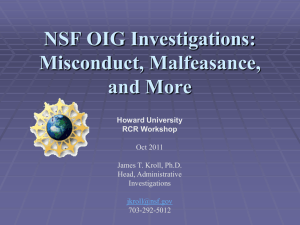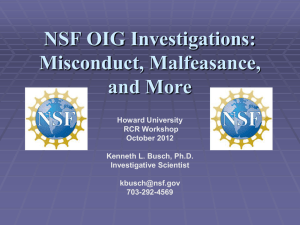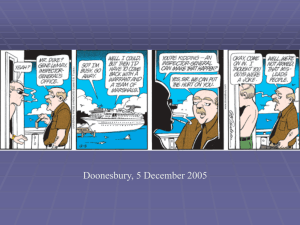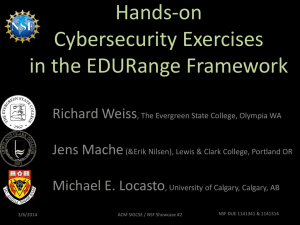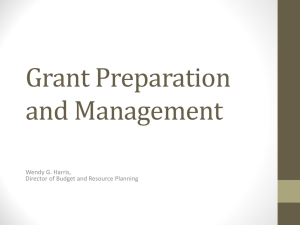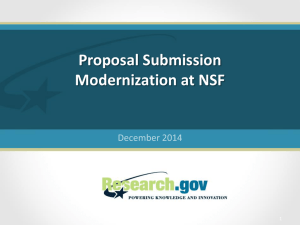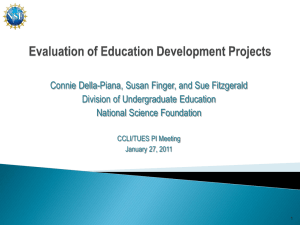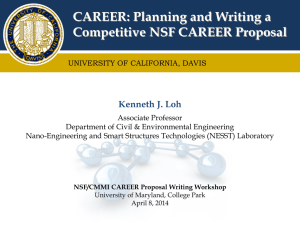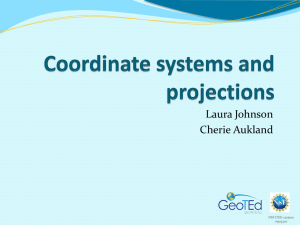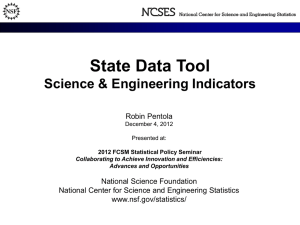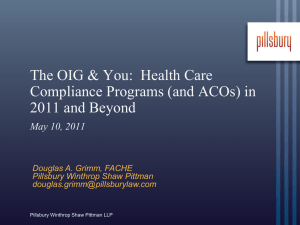NSF/OIG Stories from the Case Files
advertisement
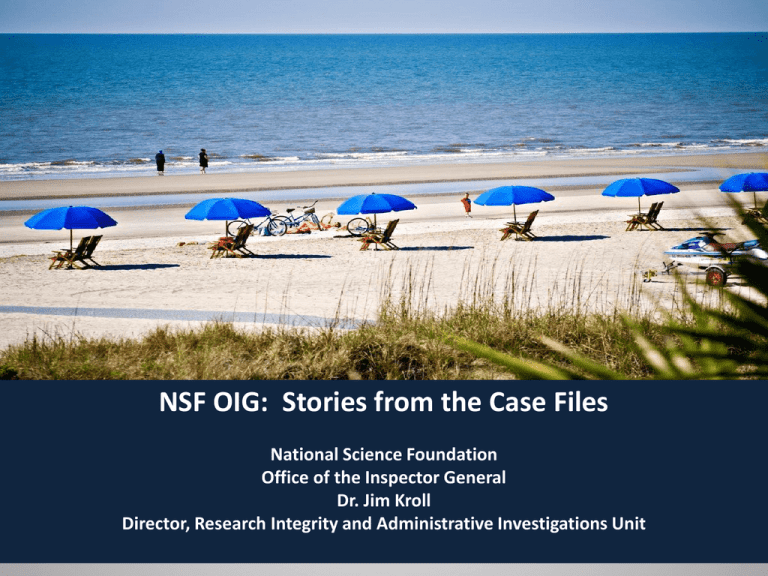
NSF OIG: Stories from the Case Files National Science Foundation Office of the Inspector General Dr. Jim Kroll Director, Research Integrity and Administrative Investigations Unit Who is NSF OIG? Inspector General (IG) Deputy IG Office of Audits Office of Legal, Legislative, and External Affairs Admin. Investigations (Investigative Scientists) Financial Audits CPA Contract Audits Grant and External Audits Performance Audits Office of Investigations Expertise in all areas of research, grant, and contract administration Civil/Criminal Investigations (Special Agents) Legal and Outreach (Investigative Attorneys) Investigations Specialists and Analysts Who is NSF OIG? – – – – Independent office reporting to the Congress and NSB. Promote economy, efficiency, and effectiveness. Prevent and detect fraud, waste, and abuse. Accomplishes mission through: • Audits • Investigations – Criminal and Civil (e.g., false claims, false statements, embezzlement). – Administrative (e.g., regulatory and policy violations). Where does research misconduct fit in? OIG is delegated the responsibility for investigating research misconduct allegations involving NSF programs. – Unique among the IG Community NSF/OIG and ORI – – – – Responsible for intake/assessment of allegations Refer matters to university for investigation Make recommendations regarding administrative actions Work together on matters of joint jurisdiction But there are some subtle differences ORI NSF Negotiates Voluntary Exclusions Refers exclusion requests to (VE) NSF/OGC Oversees grantee investigations Ability to independently investigate Not a law enforcement agency LE agency with subpoena authority Search warrant capability (criminal) Division of Education/Integrity Limited outreach by investigative staff Publishes all findings/VEs with All closeouts online but names names redacted except in debarment cases Why do we care about RM? • Fairness – An NSF proposal is a request to obtain Federal funds from the taxpayer. – NSF program officers/reviewers assess the proposers’ ability to carry out the proposed work and the proposers’ understanding of the current state of the field. – False representation of data and plagiarism misleads reviewers assessment of PI’s capabilities/knowledge • Economy, efficiency, and effectiveness – Do not want to pay for research already completed. – Do not want subsequent work to be based on misrepresented work. How does this compare to fraud? RM Relationship to Fraud Pearls Before Swine – Stephen Pastis Fraud: a misrepresentation of a material fact to induce another to act to their detriment. If NSF awards funds based on a proposal containing research misconduct – the case is analyzed under the criminal and civil fraud statutes and common law fraud doctrine. NSF funding may be temporarily suspended during the process. What is “appropriate credit”? • Depends in part on the “relevant research community.” • Basic idea: tell the reader what material you copied or paraphrased and give the reader a map back to where you got it. (Q) C R Quotation Citation Reference (Q) C R Quotation • General rule – it should be clear and obvious what is copied and what is your original work. • Distinguish material copied verbatim from your original work with quotation marks, block indentation, or other community standard. • If paraphrasing, make sure it is sufficiently paraphrased and not substantially similar text. – i.e., do not just rearrange the clauses or change every nth word to a synonym, put it in your own words. What if there is no other way to say it? technically constrained text or common phrase Hypothetical: Embedded Citations This information not only furthers our understanding of cobalamin (B12) systems [1], but also produces a large database of structural and chemical information applicable to other areas of chemistry, such as the development of molecular mechanics force fields for organocobalt systems [2]. For example, the Co–C stretching frequencies of cobaloxime models with R = CH3 are very similar to this frequency in the methyl B12 coenzyme [3]. Of particular interest here is the fact that multiple factors influence NMR chemical shifts in such models and in B12 compounds themselves [4]. Specifically, both Co anisotropy and equatorial ligand anisotropy can affect shifts [4]. Model compounds have proved to be useful in deconvoluting the various contributions to NMR shifts [5] and [6]. Moore, et al., furthers our understanding of cobalamin (B12) systems [1], and also produces a large database of structural and chemical information applicable to other areas of chemistry, such as the development of molecular mechanics force fields for organocobalt systems [2]. The Co–C stretching frequencies of cobaloxime models with R = CH3 are very similar to this frequency in the methyl B12 coenzyme [3]. Of particular interest here is the fact that multiple factors influence NMR chemical shifts in such models and in B12 compounds themselves. Specifically, both Co anisotropy and equatorial ligand anisotropy can affect shifts [7]. [7] Moore, et al. 2009 Source Subject = embedded object Community Standards • • • Institutional Policies Professional Societies Journal Policies Is there a different standard for faculty versus students? Are there different standards for proposals and peer-reviewed journals? NSF Grant Proposal Guide: The full proposal . . . • “should present the merits of the proposed project clearly and should be prepared with the care and thoroughness of a paper submitted for publication.” • “NSF expects strict adherence to the rules of proper scholarship and attribution. The responsibility for proper attribution and citation rests with authors of a proposal; all parts of the proposal should be prepared with equal care for this concern. Authors other than the PI (or any coPI) should be named and acknowledged. Serious failure to adhere to such standards can result in findings of research misconduct.” The Inquiry/Investigation Process Inquiry – Confidential; establishes substance; 120 days; may close institution ever knowing; Potential QRP letter; data fabrication usually referred Investigation - Substantive matters referred unless institution conflicted; 180 days to complete; we use institution report as basis for our investigation; OIG investigation independent – additional 180 days; may come back to you to address unanswered questions Adjudication - Institution should act only to protects its interests; OIG makes recommendations to protect federal interests; NSF adjudicates, not OIG Appeal - Director is final appeal Closeout – We will inform you of our case close. All case closeout documents are available online http://www.nsf.gov/oig/closeouts.jsp The Elements of an RM Finding • Act must meet the definition • Must be with a culpable intent (reckless, knowing or purposeful, not careless) • Preponderance of the evidence • Act must be a significant departure from accepted practice of the relevant community The Research Misconduct Finding For an NSF finding of RM the preponderance of the evidence must support: The act (e.g., plagiarism) committed by the subject; and The subject’s intent in doing the act was at least reckless. Careless Reckless Reasonable Person Standard No Finding Knowing Intentional (purposeful) Individual Standard Finding of Research Misconduct Where would you put copy-and-paste plagiarism on the intent continuum? Plagiarism Detection Methods • Review process – NSF program officers and reviewers frequently notice text copied from their own works appearing in proposals. • General complaints/allegations. • Software – – – – Only finds textual similarities not figures, images, or ideas. Does not determine plagiarism. Proactive reviews by OIG. Many programs out there with different features. BOTTOM LINE: There is no substitute for a manual analysis. Community Standards • • • Institutional Policies Professional Societies Journal Policies Is there a different standard for faculty versus students? Are there different standards for proposals and peer-reviewed journals? NSF Grant Proposal Guide: The full proposal . . . • “should present the merits of the proposed project clearly and should be prepared with the care and thoroughness of a paper submitted for publication.” • “NSF expects strict adherence to the rules of proper scholarship and attribution. The responsibility for proper attribution and citation rests with authors of a proposal; all parts of the proposal should be prepared with equal care for this concern. Authors other than the PI (or any coPI) should be named and acknowledged. Serious failure to adhere to such standards can result in findings of research misconduct.” Case Statistics Number of RM Allegations 140 120 100 80 P FF 60 FFP 40 20 0 2002 2003 2004 2005 2006 2007 2008 2009 2010 2011 2012 Case Statistics Data Fabrication/Falsification Allegations 30 Data Fabrication/Falsification Allegations PI/co-PI vs Student/Post Doc 25 20 FF Allegations 15 FF Post Doc/Student FF PI/co-PI 10 5 0 2003 2004 2005 2006 2007 2008 2009 2010 2011 2012 Case Statistics 90 80 70 60 50 Cases Completed Research Misconduct Finding 40 Debarments Cases Referred 30 20 10 0 2003 2004 2005 2006 2007 2008 2009 2010 2011 2012 Case Statistics - Trends • Allegations peaked in 2008-2010 • Upward slope on number of substantive allegations • Upward slope on the number of RM findings by NSF • Recent increase in number of substantive data fabrication allegations in research by students and post-docs • Disconcerting number of PIs who believe that copying text is ok if you include a citation to the source or if it is just “background” material • Disconcerting number of PIs who rely on post-doc or grad students to write their proposals without making sure they understand the rules/expectations • Upward trend in violations of peer review confidentiality • Conflicts between faculty and small business time and effort Why the Increase? • We are better at what we do – More experienced staff, better tools, internet • Culture clash – Explanation, not an excuse • Technology is a game changer – Makes it easier to cheat • High profile cases raises awareness regarding RM • RCR training raises awareness regarding RM • Government agency interactions with the research communities raise awareness of where complaints can be sent Avoiding the dilemma • When in doubt, make a clear distinction between what is your original work and what is someone else’s. • Know your communities’ practices (hint: look at the standards for the journals in which you publish). • When you work cross-discipline, know the other discipline’s standards also. • Adhere to the standards. • Check with work of co-authors; especially of post-docs or grad students are involved A few of our favorite excuses Can you explain why these do not work? • • • • • • • • • It’s only background material. I did not put the text taken from a specific reference in quotes since it usually makes reading a proposal difficult. The reviewers are smart enough to know what is mine and what is not. I used the same words, but I meant something different. I copied the original sources that the review paper used so it’s cited. I was told that having between 70-80 citations in a proposal was enough. Anymore and I would look like I wasn’t proposing to do something new. It’s not plagiarism if you change every seventh word. My graduate student / post doc / lab manager / etc. wrote that part. I was distracted by bird vocalizations outside my thatched roof hut, grabbed my digital camera … , and when I returned to my computer where I thought I had saved my changes to the material, it had crashed with the wrong draft saved. Case Files • • • • • • SBIR gone bad SUNY shenanigans US – Egypt program A three-fer in PA Can I borrow your awarded proposal? Disney Syndrome – It’s a small small world Contact Information www.nsf.gov/oig Hotline:1-800-428-2189 E-mail:oig@nsf.gov Fax:(703) 292-9158 Mail: 4201 Wilson Boulevard Suite II-705 Arlington, VA 22230 ATTN: OIG HOTLINE Jim Kroll jkroll @ nsf.gov 703-292-5012 ?
